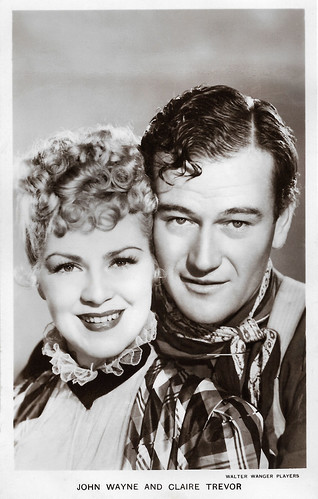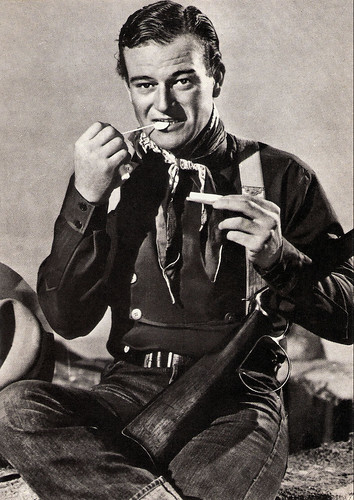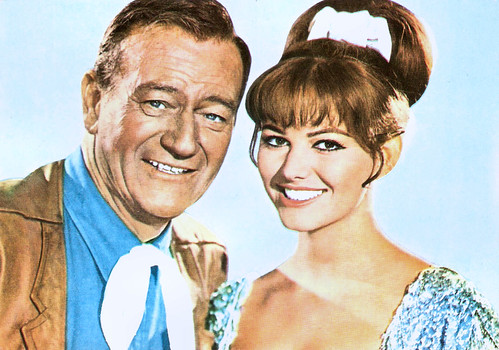
British postcard in the Picturegoer Series, London, no. 797b. Photo: Walter Wanger. John Wayne in Stagecoach (John Ford, 1939).

Belgian postcard by Fotoprim, Bruxelles (Brussels), no. 7. Photo: United Artists. John Wayne in Red River (Howard Hawks, 1948).

British postcard in the Picturegoer series, London, no W 477. Photo: British Lion / Republic Pictures.
Toiling in numerous Poverty Row Westerns
John Wayne was born Marion Robert Morrison in 1907, in Winterset, Iowa. Some sources also list him as Marion Michael Morrison and Marion Mitchell Morrison. He was already a sizable presence when he was born, weighing around 13 pounds. Marion was the oldest of their two children.
The family moved to Lancester, California, when Marion was around the age of seven. The family moved again a few years later after Clyde failed in his attempt to become a farmer. Settling in Glendale, California, Wayne received his distinctive nickname 'Duke' while living there. He had a dog by that name, and he spent so much time with his pet that the pair became known as 'Little Duke' and 'Big Duke', according to the official John Wayne website.
In high school, Wayne excelled in his classes and in many different activities, including student government and football. He also participated in numerous student theatrical productions. Winning a football scholarship to the University of Southern California (USC), Wayne started college in the fall of 1925. Unfortunately, after two years, an injury, a result of a bodysurfing accident, took him off the football field and ended his scholarship.
While in college, Wayne had done some work as a film extra, appearing as a football player in Brown of Harvard (Jack Conway, 1926) with William Haines, and Drop Kick (Millard Webb, 1927), starring Richard Barthelmess. Out of school, Wayne worked as an extra and a prop man in the film industry.
He first met director John Ford while working as an extra on Mother Machree (John Ford, 1928). With the early widescreen film epic The Big Trail (Raoul Walsh, 1930), Wayne received his first leading role, thanks to director Walsh. Sam Jacobs at Ammo.com: "Director Raoul Walsh renamed Marion Robert Morrison “John Wayne,” though Wayne would keep his birth name for the rest of his life. Wayne was not present at the meeting where his stage name was crafted. Wayne got his big break in The Big Trail, which cost a staggering $2 million (about $31.9 million in 2021 dollars). The film was shot in both 35mm and 70mm and was extremely well received by the 70mm audiences. Unfortunately, most cinemas were not equipped to show the “bigger” version of the film and it was regarded at the time as one of the all-time flops."
For nearly a decade, Wayne toiled in numerous B-films. He played the lead, with his name over the title, in many low-budget Poverty Row Westerns, mostly at Monogram Pictures and serials for Mascot Pictures Corporation. By Wayne's own estimation, he appeared in about 80 of these horse operas from 1930 to 1939. In Riders of Destiny (Robert N. Bradbury, 1933), he became one of the first singing cowboys of film, named Sandy Saunders, although via dubbing. During this period, Wayne started developing his man of action persona, which would serve as the basis of many popular characters later on.

Vintage card.

Belgian postcard by Nieuwe Merksemsche Chocolaterie S.P.R.L., Merksem. Photo: Republic Pictures. Caption: "Cette photo vous est offerte par la: Nieuwe Merksemsche Chocolaterie S.P.R.L. Avenue Rerum-Novarum 4, a Merksem (Anvers)." Collection: Daniël van der Aa.

British postcard in the Film Partners Series, London, no. P 289. Photo: Walter Wanger. John Wayne and Claire Trevor in Stagecoach (John Ford, 1939).
Romantically involved with Marlene Dietrich
Working with John Ford, John Wayne got his next big break in Stagecoach (John Ford, 1939). Because of Wayne's B-film status and track record in low-budget Westerns throughout the 1930s, Ford had difficulty getting financing for what was to be an A-budget film. After rejection by all the major studios, Ford struck a deal with independent producer Walter Wanger in which Claire Trevor, who was a much bigger star at the time, received top billing.
Wayne portrayed the Ringo Kid, an escaped outlaw, who joins an unusual assortment of characters on a dangerous journey through frontier lands. During the trip, the Kid falls for a dance hall prostitute named Dallas (Claire Trevor). The film was well-received by filmgoers and critics alike and earned seven Academy Award nominations, including one for Ford's direction. In the end, it took home the awards for Music and for Actor in a Supporting Role for Thomas Mitchell.
Wayne became a mainstream star. Reunited with Ford and Mitchell, Wayne stepped away from his usual Western roles to become a Swedish seaman in The Long Voyage Home (John Ford, 1940). The film was adapted from a play by Eugene O'Neill and follows the crew of a steamer ship as they move a shipment of explosives. Along with many positive reviews, the film earned several Academy Award nominations.
Around this time, Wayne made the first of several films with German star Marlene Dietrich. The two appeared together in Seven Sinners (Tay Garnett, 1940) with Wayne playing a naval officer and Dietrich as a woman who sets out to seduce him. Off-screen, they became romantically involved, though Wayne was married at the time. There had been rumours about Wayne having other affairs, but nothing as substantial as his connection to Dietrich. Even after their physical relationship ended, the pair remained good friends and co-starred in two more films, Pittsburgh (Lewis Seiler, 1942) and The Spoilers (Ray Enright, 1942).
Wayne's first colour film was Shepherd of the Hills (Henry Hathaway, 1941), in which he co-starred with his longtime friend Harry Carey. The following year, he appeared in his only film directed by Cecil B. DeMille, the Technicolor epic Reap the Wild Wind (1942), in which he co-starred with Ray Milland and Paulette Goddard; it was one of the rare times he played a character with questionable values.
Wayne started working behind the scenes as a producer in the late 1940s. The first film he produced was Angel and the Badman (James Edward Grant, 1947) with Gail Russell. Over the years, he operated several different production companies, including John Wayne Productions, Wayne-Fellows Productions, and Batjac Productions.

Belgian postcard by Nieuwe Merkemsche Chocolaterie S.P.R.L., Merksem. Photo: Republic Pictures. John Wayne and Gail Russell in Wake of The Red Witch (Edward Ludwig, 1948).

Italian postcard in the Photocards series by Edizioni Beatrice d'Este, no. 20096.

Dutch postcard. Photo: RKO Radio Films.
An opportunity to show his talents as an actor
John Wayne's career as an actor took another leap forward when he worked with director Howard Hawks in Red River (1948). The Western drama provided Wayne with an opportunity to show his talents as an actor, not just an action hero. Playing the conflicted cattleman Tom Dunson, he took on a darker sort of character. He deftly handled his character's slow collapse and difficult relationship with his adopted son played by Montgomery Clift.
Also around this time, Wayne also received praise for his work in John Ford's Fort Apache (1948) with Henry Fonda and Shirley Temple. Taking on a war drama, Wayne gave a strong performance in Sands of Iwo Jima (Allan Dwan, 1949), which garnered him his first Academy Award nomination for Best Actor.
He also appeared in more two Westerns by Ford now considered classics: She Wore a Yellow Ribbon (John Ford, 1949) and Rio Grande (John Ford, 1950) with Maureen O'Hara. Wayne worked with O'Hara on several films, perhaps most notably The Quiet Man (John Ford, 1952). Playing an American boxer with a bad reputation, his character moved to Ireland where he fell in love with a local woman (Maureen O'Hara). This film is considered Wayne's most convincing leading romantic role by many critics.
A well-known conservative and anticommunist, Wayne merged his personal beliefs and his professional life in Big Jim McLain (Edward Ludwig, 1952). He played an investigator working for the U.S. House Un-American Activities Committee, which worked to root out communists in all aspects of public life. Off-screen, Wayne played a leading role in the Motion Picture Alliance for the Preservation of American Ideals and even served as its president for a time. The organisation was a group of conservatives who wanted to stop communists from working in the film industry, and other members included Gary Cooper and Ronald Reagan.
In 1956, Wayne starred in another Ford Western, The Searchers (John Ford, 1956). He played Civil War veteran Ethan Edwards whose niece (Natalie Wood) is abducted by a tribe of Comanches and he again showed some dramatic range as the morally questionable veteran. He soon after reteamed with Howard Hawks for Rio Bravo (1959). Playing a local sheriff, Wayne's character must face off against a powerful rancher and his henchmen who want to free his jailed brother. The unusual cast included Dean Martin and Angie Dickinson.

Belgian collectors card. Photo: Argosy / M.G.M. John Wayne in 3 Godfathers (John Ford, 1948).

French postcard by Editions P.I., presented by Les Carbones Korès 'Carboplane', no. 839. Photo: Browning Studio / H.P.S. John Wayne in Operation Pacific (George Waggner, 1951).

French postcard by P.I., Paris, presented by Les Carbones Korès, no. 482. Photo: Warner Bros, 1953. John Wayne in Trouble Along the Way (Michael Curtiz, 1953).

German postcard by Kunst und Bild, Berlin, no. A 473. Photo: RKO Radio Films.
Refusing to even let illness slow him down
John Wayne made his directorial debut with The Alamo (John Wayne, 1960). Starring in the film as Davy Crockett, he received decidedly mixed reviews for both his on- and off-screen efforts. Wayne received a much warmer reception for The Man Who Shot Liberty Valance (John Ford, 1962) in which he played a troubled rancher competing with a lawyer (James Stewart) for a woman's hand in marriage.
Some other notable films from this period include the epics The Longest Day (Ken Annakin, Andrew Marton, Bernhard Wicki, 1962) and How the West Was Won (John Ford, Henry Hathaway, George Marshall, 1962). Continuing to work steadily, Wayne refused to even let illness slow him down. He successfully battled lung cancer in 1964. To defeat the disease, Wayne had to have a lung and several ribs removed.
In the later part of the 1960s, Wayne had some great successes and failures. He co-starred with Robert Mitchum in El Dorado (Howard Hawks, 1967), which was well-received. The next year, Wayne again mixed the professional and the political with the pro-Vietnam War film The Green Berets (Ray Kellogg, John Wayne, 1968). He directed and produced as well as starred in the film, which was derided by critics for being heavy-handed and clichéd. Viewed by many as a piece of propaganda, the film still did well at the box office.
Around this time, Wayne continued to espouse his conservative political views. He supported his friend Ronald Reagan in his 1966 bid for governor of California as well as his 1970 re-election effort. In 1976, Wayne recorded radio advertisements for Reagan's first attempt to become the Republican presidential candidate.
Wayne won his first Academy Award for Best Actor for True Grit (Henry Hathaway, 1969). He played Rooster Cogburn, a one-eyed marshal, and drunkard, who helps a young woman named Mattie (Kim Darby) track down her father's killer. A young Glen Campbell joined the pair on their mission. Rounding out the cast, Robert Duvall and Dennis Hopper were among the bad guys the trio had to defeat.
A later sequel with Katharine Hepburn, Rooster Cogburn (Stuart Millar, 1975), failed to attract critical acclaim or much of an audience. Wayne portrayed an aging gunfighter dying of cancer in his final film, The Shootist (Don Siegel, 1976), with James Stewart and Lauren Bacall. His character, John Bernard Books, hoped to spend his final days peacefully but got involved in one last gunfight.
In 1978, life imitated art with Wayne being diagnosed with stomach cancer. John Wayne died in 1979, in Los Angeles, California. He was survived by his seven children from two of his three marriages. During his marriage to Josephine Saenz from 1933 to 1945, the couple had four children, two daughters Antonia and Melinda, and two sons Michael and Patrick. Both Michael and Patrick followed in their father's footsteps: Michael Wayne as a producer and Patrick Wayne as an actor. With his third wife, Pilar Palette, he had three more children, Ethan, Aissa, and Marisa. Ethan Wayne has worked as an actor over the years.

Romanian postcard by Casa Filmului Acin. Claudia Cardinale and John Wayne in Circus World (Henry Hathaway, 1964).

West-German postcard by Krüger, no. 902/259.

Romanian postcard by Casa Filmului Acin, no. 554, no. 7. John Wayne and Barbra Streisand during the Oscars ceremony 1970. Streisand presented the Best Actor award to Wayne on the 42nd Academy Awards show. Wayne won the Oscar for his performance in True Grit (Henry Hathaway, 1969).
Sources: Sam Jacobs (Ammo.com), Biography.com, Wikipedia, and IMDb.

American postcard by Storer's Cards, Tulsa Oklahoma, no. S- 1058. Original painting: Everett Raymond Kinstler. On display at the National Cowboy Hall of Fame and Western Heritage Center, Oklahoma City, Oklahoma.
This post was last updated on 3 September 2021.
No comments:
Post a Comment